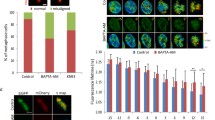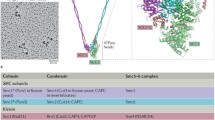Abstract
We have found that reagents that reduce oxidized cysteines lead to destabilization of metaphase chromosome folding, suggesting that chemically linked cysteine residues may play a structural role in mitotic chromosome organization, in accord with classical studies by Dounce et al. (J Theor Biol 42:275–285, 1973) and Sumner (J Cell Sci 70:177–188, 1984a). Human chromosomes isolated into buffer unfold when exposed to dithiothreitol (DTT) or tris(2-carboxyethyl)phosphine (TCEP). In micromanipulation experiments which allow us to examine the mechanics of individual metaphase chromosomes, we have found that the gel-like elastic stiffness of native metaphase chromosomes is dramatically suppressed by DTT and TCEP, even before the chromosomes become appreciably unfolded. We also report protein labeling experiments on human metaphase chromosomes which allow us to tag oxidized and reduction-sensitive cysteine residues. PAGE analysis using fluorescent labels shows a small number of labeled bands. Mass spectrometry analysis of similarly labeled proteins provides a list of candidates for proteins with oxidized cysteines involved in chromosome organization, notably including components of condensin I, cohesin, the nucleosome-interacting proteins RCC1 and RCC2, as well as the RNA/DNA-binding protein NONO/p54NRB.






Similar content being viewed by others
Abbreviations
- CAP:
-
Chromosome-associated protein
- DAPI:
-
2-(4-Amidinophenyl)-1H-indole-6-carboxamidine
- DTT:
-
Dithiothreitol
- FBS:
-
Fetal bovine serum
- HEK:
-
Human embryonic kidney (cell)
- HSA:
-
Human serum albumin
- NEM:
-
N-ethyl maleimide
- PBS:
-
Phosphate-buffered saline
- PAGE:
-
Polyacrylamide gel electrophoresis
- pN:
-
Piconewton (10−12 N)
- RCC:
-
Regulator of chromosome condensation
- SDS:
-
Sodium dodecyl sulfate
- SMC:
-
Structural maintenance of chromosome (complex)
- TCEP:
-
Tris(2-carboxyethyl)phosphine
References
Brinkley M (1992) A brief survey of methods for preparing protein conjugates with dyes, haptens, and cross-linking reagents. Bioconjug Chem 3:2–13
Bulleid NJ, Ellgaard L (2011) Multiple ways to make disulfides. Trends Biochem Sci 36:485–492
Chatterjee M, Paschal BM (2015) Disruption of the ran system by cysteine oxidation of the nucleotide exchange factor RCC1. Mol Cell Biol 35:566–581
Dounce AL, Chanda SK, Townes PL (1973) The structure of higher eukaryotic chromosomes. J Theor Biol 42:275–285
Goswami PC, Sheren J, Albee LD et al (2000) Cell cycle-coupled variation in topoisomerase IIalpha mRNA is regulated by the 3’-untranslated region. Possible role of redox-sensitive protein binding in mRNA accumulation. J Biol Chem 275:38384–38392
Hermanson GT (1996) Bioconjugate techniques. Academic, New York
Hirano T, Mitchison TJ (1994) A heterodimeric coiled-coil protein required for mitotic chromosome condensation in vitro. Cell 79:449–458
Hornick JE, Duncan FE, Sun M, Kawamura R, Marko JF, Woodruff TK (2015) Age-associated alterations in the micromechanical properties of chromosomes in the mammalian egg. J Assist Reprod Genet 32:765–769
Hudson DA, Gannon SA, Thorpe C (2015) Oxidative protein folding: from thiol-disulfide exchange reactions to the redox poise of the endoplasmic reticulum. Free Radic Biol Med 80:171–182
Hwang NR, Yim SH, Kim YM et al (2009) Oxidative modifications of glyceraldehyde-3-phosphate dehydrogenase play a key role in its multiple cellular functions. Biochem J 423:253–264
Jeppesen P, Morten H (1985) Effects of sulphydryl reagents on the structure of dehistonized metaphase chromosomes. J Cell Sci 73:245–260
Kawamura N, Dan K (1958) A cytochemical study of the sulfhydryl groups of sea urchin eggs during the first cleavage. J Biophys Biochem Cytol 4:615–619
Kawamura R, Pope LH, Christensen MO et al (2010) Mitotic chromosomes are constrained by topoisomerase II-sensitive DNA entanglements. J Cell Biol 188:653–663
Kuga T, Nakayama Y, Iwamatsu A, Fukumoto Y, Yokomori K, Yamaguchi N (2007) Separation of a disulfide-linked phosphoprotein by diagonal SDS-PAGE with optimized gel crosslinking. Anal Biochem 370:252–254
Lewis CD, Laemmli UK (1982) Higher order metaphase chromosome structure: evidence for metalloprotein interactions. Cell 29:171–181
Maeshima K, Laemmli UK (2003) A two-step scaffolding model for mitotic chromosome assembly. Dev Cell 4:467–480
Makde RD, England JR, Yennawar HP, Tan S (2010) Structure of RCC1 chromatin factor bound to the nucleosome core particle. Nature 467:562–566
Marko JF (2008) Micromechanical studies of mitotic chromosomes. Chromosom Res 16:469–497
Meikrantz W, Suprynowicz FA, Halleck MS, Schlegel RA (1990) Identification of mitosis-specific p65 dimer as a component of human M phase-promoting factor. Proc Natl Acad Sci U S A 87:9600–9604
Menon SG, Goswami PC (2007) A redox cycle within the cell cycle: ring in the old with the new. Oncogene 26:1101–1109
Menon SG, Sarsour EH, Spitz DR et al (2003) Redox regulation of the G1 to S phase transition in the mouse embryo fibroblast cell cycle. Cancer Res 63:2109–2117
Nicklas RB (1963) A quantitative study of chromosomal elasticity and its influence on chromosome movement. Chromosoma 14:276–295
Nicklas RB (1983) Measurements of the force produced by the mitotic spindle in anaphase. J Cell Biol 97:542–548
Ohta S, Bukowski-Wills JC, Sanchez-Pulido L et al (2010) The protein composition of mitotic chromosomes determined using multiclassifier combinatorial proteomics. Cell 142:810–821
Olszewska MJ, Marciniak K, Kuran H (1990) The timing of synthesis of proteins required for mitotic spindle and phragmoplast in partially synchronized root meristems of Vicia faba L. Eur J Cell Biol 53:89–92
Ono T, Losada A, Hirano M, Myers MP, Neuwald AF, Hirano T (2003) Differential contributions of condensin I and condensin II to mitotic chromosome architecture in vertebrate cells. Cell 115:109–121
Patil NA, Tailhades J, Hughes RA, Separovic F, Wade JD, Hossain MA (2015) Cellular disulfide bond formation in bioactive peptides and proteins. Int J Mol Sci 16:1791–1805
Poirier MG, Marko JF (2002) Mitotic chromosomes are chromatin networks without a mechanically contiguous protein scaffold. Proc Natl Acad Sci U S A 99:15393–15397
Poirier M, Eroglu S, Chatenay D, Marko JF (2000) Reversible and irreversible unfolding of mitotic newt chromosomes by applied force. Mol Biol Cell 11:269–276
Pope LH, Xiong C, Marko JF (2006) Proteolysis of mitotic chromosomes induces gradual and anisotropic decondensation correlated with a reduction of elastic modulus and structural sensitivity to rarely cutting restriction enzymes. Mol Biol Cell 17:104–113
Rapkine L (1931) Su les processus chimiques au cours de la division cellulaire. Ann Physiol Physiochem Biol 7:382–418
Samejima K, Samejima I, Vagnarelli P et al (2012) Mitotic chromosomes are compacted laterally by KIF4 and condensin and axially by topoisomerase IIα. J Cell Biol 199:755–770
Sarsour EH, Kumar MG, Chaudhuri L, Kalen AL, Goswami PC (2009) Redox control of the cell cycle in health and disease. Antioxid Redox Signal 11:2985–3011
Sarsour EH, Kalen AL, Goswami PC (2014) Manganese superoxide dismutase regulates a redox cycle within the cell cycle. Antioxid Redox Signal 20:1618–1627
Sevier CS, Kaiser CA (2002) Formation and transfer of disulphide bonds in living cells. Nat Rev Mol Cell Biol 3:836–847
Shintomi K, Takahashi TS, Hirano T (2015) Reconstitution of mitotic chromatids with a minimum set of purified factors. Nat Cell Biol 17:1014–1023
Sone T, Iwano M, Kobayashi S et al (2002) Changes in chromosomal surface structure by different isolation conditions. Arch Histol Cytol 65:445–455
Struchkov VA, Strazhevskaia NB (1989) Specific disulfide links of the DNA residual protein complex. Dokl Akad Nauk SSSR 307:755–758
Struchkov VA, Strazhevskaya NB (1994) Significance of specific protein S-S bonds in the structural-functional organization of DNA. Bull Exp Biol Med 118:875–878
Struchkov VA, Strazhevskaya NB, Blokhin DY (1992) Thiol-Induced fragmentation of chromosomal DNA. Bull Exp Biol Med 113:716–719
Struchkov VA, Strazhevskaya NB, Blokhin DY (1995) Role of the disulfide bridges of the residual protein in the structure of chromosomal DNA. Biofizika 40:296–316
Sumner AT (1984a) Distribution of protein sulphydryls and disulphides in fixed mammalian chromosomes, and their relationship to banding. J Cell Sci 70:177–188
Sumner AT (1984b) X-ray microanalysis of protein sulfhydryl-groups in chromatin. Scan Electron Microsc, PT 2:897–904
Sun M, Kawamura R, Marko JF (2011) Micromechanics of human mitotic chromosomes. Phys Biol 8:015003
Takata H, Uchiyama S, Nakamura N et al (2007) A comparative proteome analysis of human metaphase chromosomes isolated from two different cell lines reveals a set of conserved chromosome-associated proteins. Genes Cells 12:269–284
Uchiyama S, Kobayashi S, Takata H et al (2005) Proteome analysis of human metaphase chromosomes. J Biol Chem 280:16994–17004
Vagnarelli P, Hudson DF, Ribeiro SA et al (2006) Condensin and Repo-Man-PP1 co-operate in the regulation of chromosome architecture during mitosis. Nat Cell Biol 8:1133–1142
Yang J, Carroll KS, Liebler DC (2016) The expanding landscape of the thiol redox proteome. Mol Cell Proteomics 15:1–11
Acknowledgments
This work was supported by the NSF through grants MCB-1022117 and DMR-1206868 and by the NIH through grants R01-GM105847 and U54-CA193419 and by subcontract to U54-DK107980. Work at the Northwestern Proteomics Core was supported in part by the Northwestern Office of Research and the Feinberg School of Medicine.
Author information
Authors and Affiliations
Corresponding author
Ethics declarations
Ethical standards
The experiments described in this article comply with the current laws of the country where they were performed (USA). This article does not contain any studies with human or animal subjects performed by any of the authors.
Conflicts of interest
The authors declare that they have no conflicts of interest.
Additional information
Responsible Editor: Tatsuo Fukagawa, Ph.D
Rights and permissions
About this article
Cite this article
Eastland, A., Hornick, J., Kawamura, R. et al. Dependence of the structure and mechanics of metaphase chromosomes on oxidized cysteines. Chromosome Res 24, 339–353 (2016). https://doi.org/10.1007/s10577-016-9528-6
Received:
Revised:
Accepted:
Published:
Issue Date:
DOI: https://doi.org/10.1007/s10577-016-9528-6




